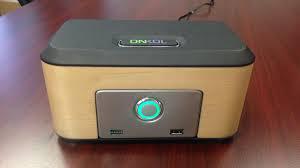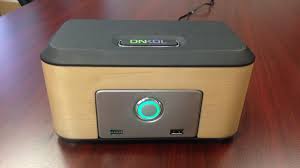
Driven by the urge to know what his mother, who had recently beaten back colon cancer, was doing at home alone and how she was doing, Marc Cayle designed a device named Onkol that allows him to keep track of his mother, Shari Cayle (75), while he was away with work.
The device created by Marc monitors Shari’s front door, reminds her to when to take her medication and can alert her family if she falls has allowed her to remain independent at home, even when relatives leave her alone at home to attend work.
"I don’t want my grandchildren to remember me as the sick one, I want to be the fun one. My family knows what I’m doing and I don’t think they should have to change their life around to make sure I’m OK," says Cayle, who is testing a device that passively monitors her activity while she till undergoes treatment staying alone.
Onkol is essentially a tissue box sized rectangular hub that can sense actions like passively monitoring what the blood glucose reading of the user and alerts the family when the user opens their refrigerator. In an emergency, there is also a wrist band that can be pressed to get help.
"The advantage of it is that the person, the patient, doesn’t have to worry about hooking it up and doing stuff with the computer, their kids do that," said Cayle, whose son co-founded Onkol.
Marc plans to commercially market the products in the US market sometime next year.
Experts are of the opinion that such devices, created by startups, that connect the old to their families and healthcare providers was gaining popularity as more American seniors plan to remain at home rather than enter a nursing facility.
Users can go about their normal routine as the devices quietly monitor their activity and react to deviation from preset activities or reminds them to undergo activities set into the devices.
The information that the devices gather are sent to the family or the doctor through Bluetooth technology. For example, activities such as the opening up of a pill box or using a wireless medical device such as a glucose monitor are sensed by the devices and the information is relayed to the family or the doctor or both.
In the next 20 years, at-home options like these will disrupt roughly $64 billion of traditional U.S. provider revenue, says PricewaterhouseCoopers' Health Research Institute.
The concept of such devices is however not new. For example the privately-held Life Alert had hit the public awareness about 30 years ago and was advertised on TV where an elderly lady was seen reaching for her Life Alert pendant and telling an operator, "I’ve fallen and I can’t get up!"
Given the advancement in technology companies like Nortek Security & Control and other small startups are taking the concept much further and adding a host of value add- on-s.
“There’s a lot of potential, but a big gap between what seniors want and what the market can provide,” said Harry Wang, director of health and mobile product research at Parks Associates.
(Source:www.reuters.com & www.digitallook.com)
The device created by Marc monitors Shari’s front door, reminds her to when to take her medication and can alert her family if she falls has allowed her to remain independent at home, even when relatives leave her alone at home to attend work.
"I don’t want my grandchildren to remember me as the sick one, I want to be the fun one. My family knows what I’m doing and I don’t think they should have to change their life around to make sure I’m OK," says Cayle, who is testing a device that passively monitors her activity while she till undergoes treatment staying alone.
Onkol is essentially a tissue box sized rectangular hub that can sense actions like passively monitoring what the blood glucose reading of the user and alerts the family when the user opens their refrigerator. In an emergency, there is also a wrist band that can be pressed to get help.
"The advantage of it is that the person, the patient, doesn’t have to worry about hooking it up and doing stuff with the computer, their kids do that," said Cayle, whose son co-founded Onkol.
Marc plans to commercially market the products in the US market sometime next year.
Experts are of the opinion that such devices, created by startups, that connect the old to their families and healthcare providers was gaining popularity as more American seniors plan to remain at home rather than enter a nursing facility.
Users can go about their normal routine as the devices quietly monitor their activity and react to deviation from preset activities or reminds them to undergo activities set into the devices.
The information that the devices gather are sent to the family or the doctor through Bluetooth technology. For example, activities such as the opening up of a pill box or using a wireless medical device such as a glucose monitor are sensed by the devices and the information is relayed to the family or the doctor or both.
In the next 20 years, at-home options like these will disrupt roughly $64 billion of traditional U.S. provider revenue, says PricewaterhouseCoopers' Health Research Institute.
The concept of such devices is however not new. For example the privately-held Life Alert had hit the public awareness about 30 years ago and was advertised on TV where an elderly lady was seen reaching for her Life Alert pendant and telling an operator, "I’ve fallen and I can’t get up!"
Given the advancement in technology companies like Nortek Security & Control and other small startups are taking the concept much further and adding a host of value add- on-s.
“There’s a lot of potential, but a big gap between what seniors want and what the market can provide,” said Harry Wang, director of health and mobile product research at Parks Associates.
(Source:www.reuters.com & www.digitallook.com)





